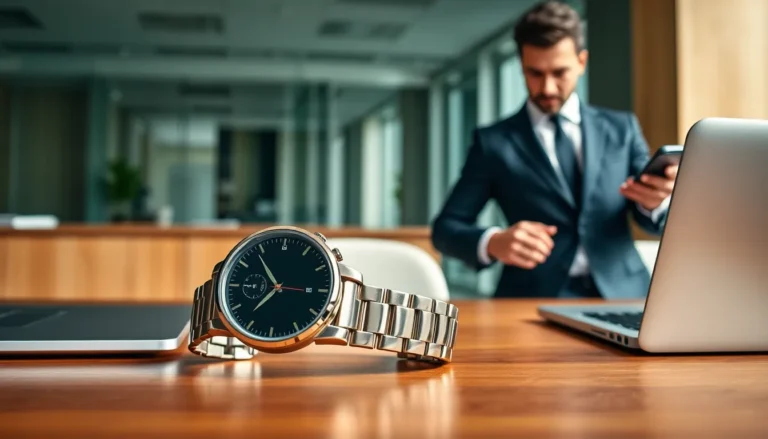Ever felt like your iPhone 11 is auditioning for a role in a summer blockbuster? It’s not just you; many users wonder why their device gets hotter than a jalapeño in a sauna. While it might seem like your phone’s trying to cook up a storm, there are perfectly normal reasons behind that heat.
Table of Contents
ToggleUnderstanding the iPhone 11 Heating Issue
It’s common for the iPhone 11 to experience some heat during intensive tasks. Users often notice warmth during activities like gaming, streaming, or using GPS, which require substantial processing power. The device includes powerful components designed to handle these demands, resulting in increased heat generation.
Additionally, environmental factors can contribute to the heating issue. Using the iPhone 11 in direct sunlight or hot conditions raises the device’s temperature. The phone is engineered to prevent damage from excessive heat, automatically slowing down performance if temperatures rise beyond safe levels.
Battery usage also plays a significant role. As the battery discharges rapidly under heavy usage, it generates heat. Background applications running without user awareness can strain the battery, leading to increased warmth. Checking and closing unused apps helps alleviate some of this stress.
Charging habits impact temperature as well. Utilizing non-certified chargers or charging in enclosed spaces can trap heat. Opting for Apple’s certified accessories ensures proper performance and minimizes the risk of overheating.
Software updates regularly help optimize thermal management. Keeping the iPhone 11 updated allows users to benefit from Apple’s latest performance features, including better heat regulation. Users should enable automatic updates to stay current.
Overall, it’s normal for the iPhone 11 to become warm during certain activities. Understanding these factors helps users manage heat effectively while enjoying their device’s capabilities.
Common Causes of Overheating
iPhone 11 users often encounter heat issues due to various factors affecting device performance. Understanding these causes can help manage heat effectively.
Intensive Apps and Usage
Intensive apps contribute significantly to overheating. Gaming, streaming, and navigation tax the processor and can generate heat quickly. Using multiple apps simultaneously amplifies this effect. Resource-heavy applications demand high processing power, which, in turn, makes the device work harder. Users who frequently engage in these activities often notice temperature increases. Closing unused applications helps reduce this strain, allowing the iPhone 11 to function more efficiently.
Environmental Factors
Environmental conditions play a critical role in device temperature. Direct sunlight raises the device’s temperature significantly. Extreme heat or humidity can also exacerbate the issue. Using the iPhone 11 outdoors on a hot day means it may struggle to maintain optimal performance levels. Keeping the device in a cool, shaded area can alleviate temperature issues. Storing the iPhone in overly warm environments, such as vehicles, leads to further overheating problems.
Hardware Limitations
Hardware limitations impact how well the iPhone 11 manages heat. Components like the CPU and GPU are powerful but can only handle so much without generating excess heat. Continuous high-performance tasks challenge these components, leading to thermal throttling. If the battery is under heavy load, heat generation increases. Using non-certified accessories for charging also affects performance and can cause overheating. Users looking for optimal performance should ensure their device is regularly maintained and updated.
Solutions to Prevent Overheating
To keep the iPhone 11 cool, users can implement several effective strategies.
Optimizing Settings
Reducing screen brightness minimizes energy consumption, which helps control heat. Enabling Low Power Mode decreases background activity and optimizes performance. Turning off features like location services for apps that don’t require them also conserves battery life. Users can adjust these settings in the device’s menu easily. Regularly checking for software updates ensures optimal performance, as updates often contain improvements for thermal management.
Managing Apps
Limiting the number of apps running in the background significantly reduces strain on the processor. Checking the battery usage for apps allows users to identify resource-hungry applications. Closing unused or unnecessary apps can greatly lower heat generation. Users can also uninstall apps that experience significant usage spikes or constant updates. Scheduling intensive tasks for cooler parts of the day further minimizes heat buildup during high-demand applications.
Avoiding Direct Sunlight
Keeping the iPhone 11 out of direct sunlight prevents excess heat from external sources. Taking breaks from direct exposure during use, especially while sunbathing or walking outdoors, helps maintain a cooler temperature. Users should also park their devices in shaded areas whenever possible. Storing the phone in enclosed spaces like cars can trap heat, so keeping it in a cooler place aids in temperature regulation. By implementing these measures, users can enhance their device’s performance and longevity.
When to Seek Professional Help
Signs of significant overheating demand attention. If the iPhone 11 shows persistent high temperatures despite following recommended practices, users should consider professional assistance. Frequent shutdowns or performance slowdowns signal that a deeper issue might exist.
Battery health plays a critical role in device performance. Checking battery status through settings is essential. If the maximum capacity is significantly diminished, replacement might be necessary.
Unusual sounds or smell of burning plastic can indicate serious hardware problems. Turning off the device promptly and seeking help can prevent further damage. Users should also observe swelling in the battery, as this poses safety risks.
Software glitches can also contribute to overheating. If restarting the device or updating the software doesn’t improve performance, a visit to a certified technician may be warranted.
Additionally, persistent issues after troubleshooting steps point to potential hardware damage. Engaging with professional services ensures that repairs are conducted correctly and safely.
Lastly, frequent overheating during simple tasks or after becoming fully charged suggests that routine maintenance is due. Professionals can assess device components and software configurations to restore normal functionality.
Understanding why an iPhone 11 gets hot can help users manage their devices more effectively. With the right practices in place overheating can often be mitigated. By optimizing settings and being mindful of environmental conditions users can enhance performance and extend the lifespan of their device.
It’s important to remember that while some warmth is normal during intensive tasks, persistent overheating may indicate a need for professional evaluation. Regular maintenance and awareness of battery health can prevent more serious issues down the line. By taking proactive steps users can enjoy their iPhone 11 without the worry of excessive heat.


